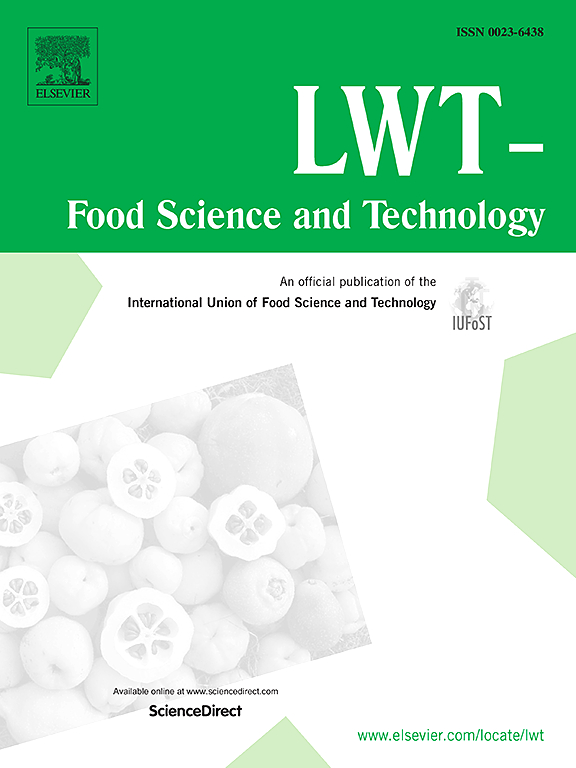Comparative analysis of microbial communities and flavor compounds in fermented grains from different sorghum varieties used in Sichuan Xiaoqu liquor
IF 6
1区 农林科学
Q1 FOOD SCIENCE & TECHNOLOGY
引用次数: 0
Abstract
Sorghum is the primary raw material for liquor brewing, and its increasing cost has significantly impacted liquor manufacturers. In response, the industry is exploring the possibility of using low-cost imported sorghum as an alternative to domestic sorghum. The present study monitored the physicochemical properties, flavor components, and microbial community structure of fermented grains during the fermentation of Australian sorghum (AS) and Northeastern sorghum (DS) in real-time. Additionally, the correlation between microbial communities and the flavor of Xiaoqu liquor was investigated. Fermentation was analyzed over five periods: 0, 2, 4, 6, and 8 days. The reducing sugar content of DS was significantly higher than that of AS in the early stage, while the starch content remained consistently higher than that of DS. The acidity of both fermented grains showed an increasing trend, whereas moisture content and fermentation temperature remained relatively stable. A total of 52 flavor compounds were detected, with alcohols being the most abundant aroma compounds. The three most differentiated volatile flavor compounds were [V3] isopentyl formate, [V26] 6-methylheptan-1-ol, and [V16] 9-hexadecenoic acid, ethyl ester. A total of 90 bacterial and 46 fungal genera were identified. The dominant bacterial genera in AS were Lactobacillus, Bacillus, Pediococcus, and Acinetobacter, while the dominant fungal genera were Saccharomyces, Saccharomycopsis, and Cutaneotrichosporon. In DS, the dominant bacterial genera were Lactobacillus, Bacillus, Pediococcus, and Enterobacter, while Saccharomyces and Saccharomycopsis were the dominant fungal genera. The AS bacterial community showed stronger microbial interactions, resulting in a more complex and tightly interconnected bacterial network, whereas its fungal network structure remained relatively simple. Correlation analyses further demonstrated that alcohols and hydrocarbons were strongly correlated with bacterial metabolic activity, and AS microorganisms exhibited weaker correlations with flavor compounds. This study provides a comprehensive comparison of the fermentation characteristics of AS and DS, offering a theoretical foundation and valuable data for optimizing the use of Australian sorghum in Xiaoqu liquor production.
四川小曲酒不同高粱品种发酵粮食中微生物群落和风味化合物的比较分析
本文章由计算机程序翻译,如有差异,请以英文原文为准。
求助全文
约1分钟内获得全文
求助全文
来源期刊

LWT - Food Science and Technology
工程技术-食品科技
CiteScore
11.80
自引率
6.70%
发文量
1724
审稿时长
65 days
期刊介绍:
LWT - Food Science and Technology is an international journal that publishes innovative papers in the fields of food chemistry, biochemistry, microbiology, technology and nutrition. The work described should be innovative either in the approach or in the methods used. The significance of the results either for the science community or for the food industry must also be specified. Contributions written in English are welcomed in the form of review articles, short reviews, research papers, and research notes. Papers featuring animal trials and cell cultures are outside the scope of the journal and will not be considered for publication.
 求助内容:
求助内容: 应助结果提醒方式:
应助结果提醒方式:


